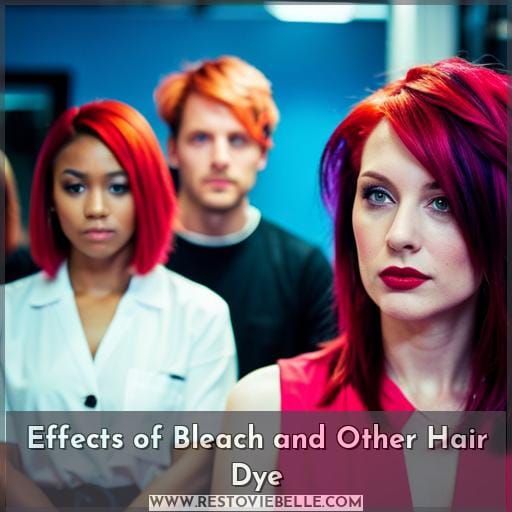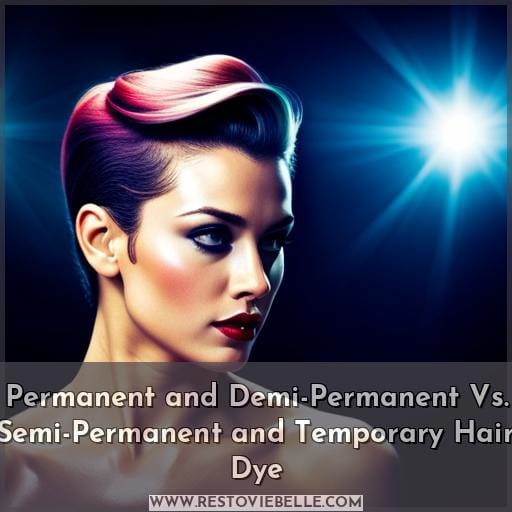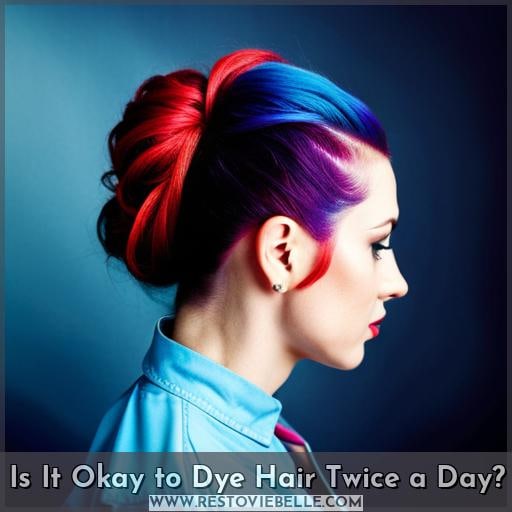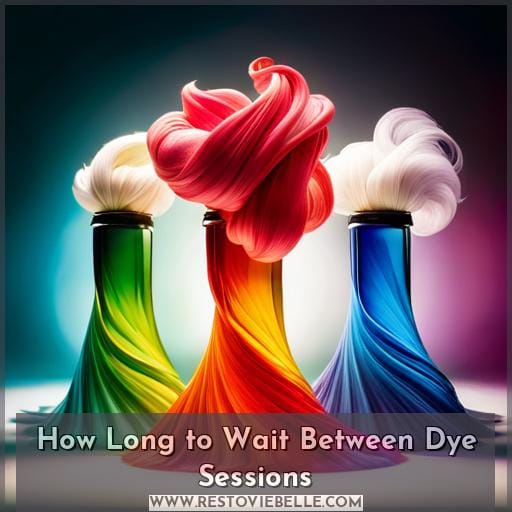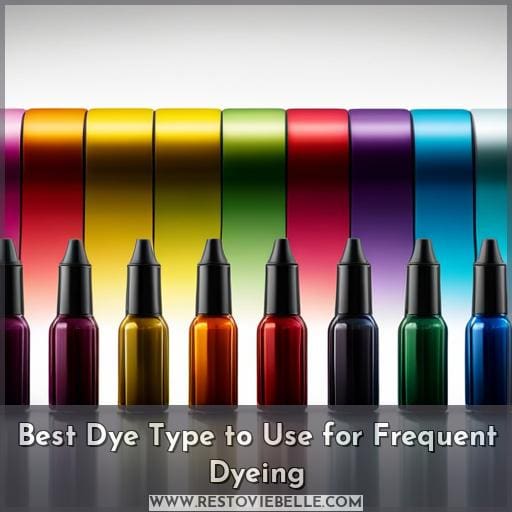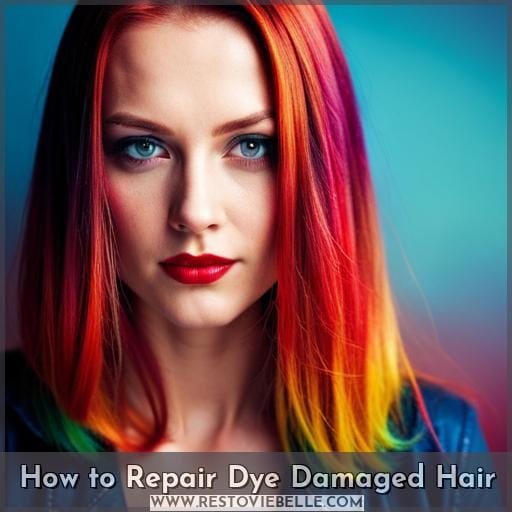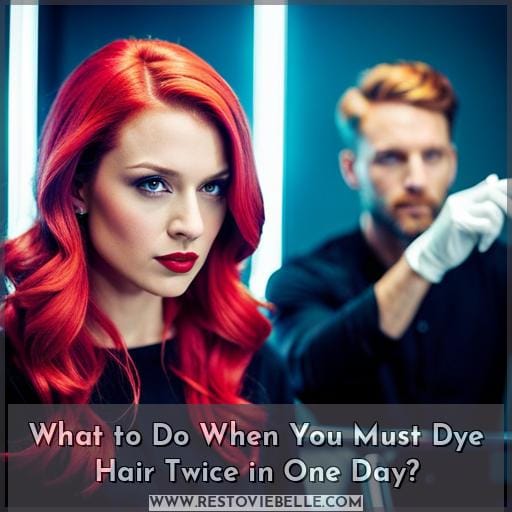This site is supported by our readers. We may earn a commission, at no cost to you, if you purchase through links.
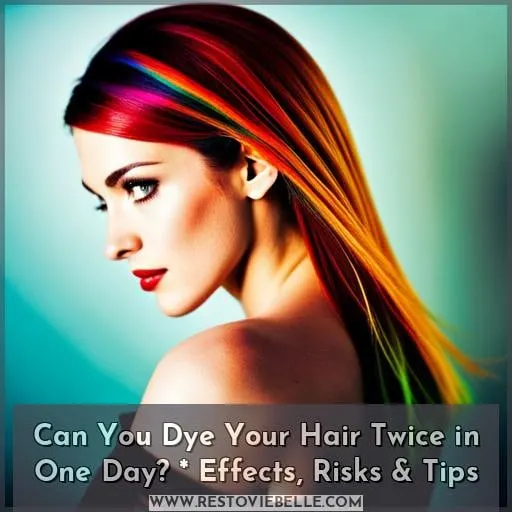 We know the feeling – excited to dye your hair, only for it not to turn out quite like you expected. You might be tempted to try again right away but can you actually dye your hair twice in one day? The answer is usually no: too much of a good thing isn’t always best when it comes to chemical treatments on your mane.
We know the feeling – excited to dye your hair, only for it not to turn out quite like you expected. You might be tempted to try again right away but can you actually dye your hair twice in one day? The answer is usually no: too much of a good thing isn’t always best when it comes to chemical treatments on your mane.
But there are factors that play into how often and what kind of treatment is safe for your tresses.
Read on as we uncover the effects, risks, and tips associated with coloring or bleaching multiple times in one day so that you can make an informed decision about whether taking this step is right for you.
Table Of Contents
- Key Takeaways
- What Happens When You Dye Hair Twice in One Day?
- Effects of Bleach and Other Hair Dye
- Permanent and Demi-Permanent Vs. Semi-Permanent and Temporary Hair Dye
- Why You Shouldn’t Dye Your Hair Twice in One Week
- Can You Bleach Your Hair Twice in a Week?
- Is It Okay to Dye Hair Twice a Day?
- How Long to Wait Between Dye Sessions
- Best Dye Type to Use for Frequent Dyeing
- How to Repair Dye Damaged Hair
- What to Do When You Must Dye Hair Twice in One Day?
- Frequently Asked Questions (FAQs)
- Conclusion
Key Takeaways
- Dyeing hair twice in one day can lead to serious damage and split ends.
- Too much coloring weakens strands and can cause breakage over time.
- Color correction should involve professional guidance for better results and less risk.
- Bleaching carries extreme risks; try semi-permanent dyes for gentler deposits on the cuticle.
What Happens When You Dye Hair Twice in One Day?
If you’re considering dyeing your hair twice in one day, it’s important to be aware that this can lead to serious damage and potential split ends. In fact, professionals advise against frequent dyeing due to the consequences it can have on your hair.
It’s essential to know what type of dye you will use – permanent or demi-permanent – and to follow safety instructions when lightening brown hair.
Color correction should always involve professional guidance for better results with less risk. Bleaching carries extreme risks, so it’s recommended to try semi-permanent dyes for gentler deposits on the cuticle without compromising the quality of the color change outcomes.
Frequency considerations depend on the desired color effect. If necessary, opt for protein-rich products like conditioners and shampoo between sessions. However, it’s important to remember that too much coloring weakens strands and can lead to breakage over time.
According to Aida’s blog, if done correctly and with caution, twice-weekly coloring may be possible. However, it’s crucial to take into account all factors, such as healthier hair maintenance regimens following each session.
It’s not recommended to attempt re-dyeing on the same day, as it can lead to inconsistent and unpredictable results.
Effects of Bleach and Other Hair Dye
Now, let’s discuss the effects of bleach and other hair dyes. When it comes to bleaching, you should be aware that there are extreme risks involved with this process. Not only can it cause immense damage to your hair, but you should wait at least 4-6 weeks between each session in order for your hair health not to suffer too much.
It is highly recommended that anyone considering lightening their locks consult a professional hairstylist for safe color correction guidance, as well as advice on how long they need to wait between sessions according to their dye type and desired color change.
Furthermore, if you do decide to use heat styling tools or any sort of chemical reaction products such as peroxide or toner on your hair, then make sure these are used sparingly.
Hair processing products, such as shampoos designed specifically for colored tresses, will help keep vibrant results while helping protect from further harm caused by excessive dyeing.
Permanent and Demi-Permanent Vs. Semi-Permanent and Temporary Hair Dye
You can choose between permanent or demi-permanent dye for more lasting results, and semi-permanent or temporary dye if you’re after a quick change.
Permanent dyes penetrate the cuticle layer of your hair to create longer-lasting color that won’t wash out easily, while demi-permanent dyes are slightly less intensive and will need to be touched up every few weeks.
Semi-permanent colors provide a conditioning effect that adds another layer of pigment on top of the cuticle without lightening it.
Temporary color solutions are best used for short-term makeovers and repair as they don’t contain any bleaching agents like ammonia, which can damage your hair.
When considering protecting your hair from potential damage caused by coloring processes such as bleaching risks, waiting time between sessions is important.
Why You Shouldn’t Dye Your Hair Twice in One Week
Dyeing your tresses more than once a week can be detrimental to its health, so it’s best to take a cautious approach and wait at least one week between sessions. When considering recoloring hair, the re-dye timeline varies depending on dye type and color change desired.
For instance, if lightening brown hair is the goal, then incremental lightening with purple shampoo is recommended. On the other hand, transitioning red to brown may depend on whether you use semi-permanent or demi-permanent dyes – both of which are ideal for frequent coloring but should not be used twice in one day due to potential cuticle damage from harsh chemicals like bleach.
Hair health must also be taken into account when deciding upon dye frequency. Regular trims combined with deep conditioning treatments and protein-rich products will help avoid extreme damage caused by bleaching that might require waiting 4–6 weeks until the next session.
Consultation from professionals is always advised for optimal results. Corrective color correction guidance will ensure safe use of bleach along with minimizing any potential risks associated with the double-dyeing process in a single day, such as dryness or split ends resulting from rough edges flaking off during the first round of dye application.
With all these factors considered together, plus internal nourishment through hydration and supplements for overall well-being, vibrant long-lasting results can still be achieved without compromising your hair’s integrity and shine!
Can You Bleach Your Hair Twice in a Week?
Bleaching your hair twice in a week may seem like a good idea, but caution is advised as it can cause serious damage to your tresses. The risks of bleaching are extreme, and the waiting period between sessions should be at least four to six weeks.
To correct hair color or transition from blonde to brown safely, consult with a hairstylist for guidance. Consider using semi-permanent or demi-permanent dyes instead of bleaches, as they will damage the cuticle layer of your locks.
For healthy results when dyeing twice in one day, use protein-rich products and moisturizing treatments during the process, as well as afterward for maintenance purposes. Gently styled hair (avoid tight styles), UV protection, limited heat exposure, hydration, and supplements can help keep dyed strands healthy while changing up colors frequently without sacrificing quality over time.
When deciding if you can double dye on any given day, weigh out factors such as desired shade change intensity, type of color used, existing health state, and timing limitations.
Is It Okay to Dye Hair Twice a Day?
Making the decision to dye your hair twice in one day is like walking a tightrope – you must be careful and take calculated risks for a successful outcome. Depending on the type of dye used, double-dyeing can cause extreme damage to your hair health.
It’s best to use semi or demi-permanent dyes, which are gentler than permanent ones and deposit color onto the cuticle layer without lightening it.
When transitioning from one color tone to another, toning blue shampoos may help neutralize unwanted orange undertones, while purple shampoo helps retain cool tones in blonde shades. If gradual lightening is desired, opt for incremental steps using direct dyes that don’t contain bleach nor ammonia, so as not to overly stress tresses with multiple processes within short timeframes.
Finally, consult professionals when considering any major alterations, especially those involving bleaching, since its effects are unpredictable but almost always irreversible!
How Long to Wait Between Dye Sessions
With so many dye options available, it can be difficult to decide which one is best for you. Permanent dyes contain strong chemicals that penetrate the hair shaft, demi-permanent colors add a layer of pigment on top of your existing color, and semi-permanent colors are the most gentle but do not lighten or drastically change your shade.
Knowing how long to wait between dye sessions will help ensure vibrant results with minimal damage.
Permanent Dye
When you’re looking for long-lasting color, permanent dye can be a great option. However, to ensure the safety of your hair and get the best results, it’s important to follow the correct procedures when dyeing multiple times in one day.
To avoid the dangers of bleach, it’s best to use toners or semi-permanent dyes instead. This will help protect your hair from damage caused by frequent coloring sessions and maintain the desired tone balancing effects over time.
Consider taking breaks in between each application of permanent hair color products. It’s recommended to wait at least three days, if not more, to give your hair a chance to recover.
Additionally, always remember that healthy color-treated locks require proper care. This includes deep conditioning treatments with protein-rich products and regular trims.
Demi-Permanent Dye
Demi-permanent dyes provide a gentler color deposit than permanent dyeing, drastically reducing the risk of hair damage if you’re looking to switch up your look twice in one day. This also offers protection from fading and helps maintain lightening brown or any other desired hue for longer periods.
Color correction is easily achieved with demi-permanent dye, while nourishment and hydration are locked into every strand thanks to UV protection.
Semi-Permanent Dye
Ready to make a bold change without the commitment? Semi-permanent dyes offer vibrant, lasting color and can be safely used twice in one day with proper care. To avoid damage, opt for dye types that don’t require bleach or lightening. Incorporate colored waxes or hair dye mixed with conditioner to keep it looking fresh longer.
Best Dye Type to Use for Frequent Dyeing
You’re looking for vibrant, long-lasting color that won’t damage your hair? Look no further than semi-permanent or demi-permanent dyes—they offer a safe way to transform your look without the consequences of frequent dyeing.
These types of dyes are gentler and deposit color on only the cuticle layer, helping to protect against split ends and brittleness caused by bleaching compounds. The key is in minimizing exposure time; limit each session to three days at most.
Furthermore, use protective measures like deep conditioning treatments before coloring as well as protein-rich products afterwards for healthier locks between sessions.
Invest in regular trims too; this helps reduce visible signs of breakage from overprocessing when it comes time for another dye job down the road! With these tips in mind, you’ll have beautiful colored hair with minimal risk involved – perfect if double dying is necessary every now and then!
How to Repair Dye Damaged Hair
To repair dye-damaged hair, it’s important to give your locks a break between sessions and nourish them with protein-rich products.
- Regular trims to keep ends healthy.
- Deep conditioning treatments that include UV protection.
- Incorporating vitamin-rich supplements into your diet for the overall health of the hair shafts from the inside out.
Dyeing twice in one day can cause severe damage due to cuticle disruption, so caution is advised when attempting this method, especially if bleaching is involved. Opt instead for gradual lightening techniques like using purple shampoo or toners rather than bleach when dealing with brown-colored strands transitioning to lighter shades or vice versa if darkening blonde tresses.
These processes tend not to be as damaging on the integrity of individual hairs over time compared with double processing in a single session. Results may be inconsistent and unpredictable, leading to further possible harm down the line, no matter which type you choose – permanent, demi-permanent, or semi-permanent dyes all have their limitations depending upon the desired outcome.
Waiting periods should always apply after each use, regardless of whether going darker, lighter, or the same shade, in order to get optimal color results without sacrificing hair health. It is also important to allow protective measures such as gentle styling habits and limit heat exposure to complete the look.
What to Do When You Must Dye Hair Twice in One Day?
If you must double-dye your tresses in a day, take caution for cutting corners can cause catastrophic consequences. When it comes to dyeing hair twice in one day, there are many factors and safety measures to consider.
It is important to be aware of the risks associated with different types of dyes and chemical damages from bleaching that could occur when attempting such a feat. To reduce potential harm, time limits should be followed for each step as well as specific guidelines based on desired color changes or dye types used.
Hair treatment products, such as protein-rich masks or deep conditioners, prior to any type of coloring can help reduce damage and maintain healthy locks after double hair dyeing sessions within a day’s time frame have been completed successfully.
Professionals advise against frequent coloring due to gradual fading from overuse; however, if done correctly with care following all safety requirements necessary, customers will achieve vibrant results without causing too much physical stress on their mane!
Frequently Asked Questions (FAQs)
How often should you dye your hair?
Dyeing your hair too often can cause damage, so it’s best to wait at least 3-4 weeks between dye sessions. For optimal results and healthier hair, seek professional advice from a hairstylist and opt for gentle colors like semi-permanent or demi-permanent dye options.
Is it safe to dye hair twice in one day?
It is generally not safe to dye your hair twice in one day. Cuticle damage, dryness, and split ends can occur; certain types of dyes should be used with caution. For optimal results and healthier hair, wait several days between sessions – consult a professional if necessary for guidance on color correction.
What is the best way to lighten brown hair?
To lighten brown hair, use a toner to slightly lift the color while toning. Opt for an incremental lightening approach and add purple shampoo or conditioner to maintain cool tones. Follow professional advice when using bleach, and if in doubt, wait 4-6 weeks between sessions for healthier results.
How can I transition from red to brown hair?
Transitioning from red to brown? A semi- or demi-permanent dye is ideal. Time it right: wait after bleaching and go gradually for best results. Avoid same-day dyeing; opt for a deep conditioning treatment instead! And don’t forget healthy hair maintenance – regular trims, protection, internal nourishment.
What are the best products to use for healthy hair dyeing?
Get vibrant, healthy hair dye results with the right products. Choose semi-permanent or demi-permanent dyes for frequent coloring, and use a toner to balance out dark blonde and pre-bleached hair. Opt for an anti-brass shampoo to reduce orange tones in natural or highlighted locks; try Color Balance Blue Conditioner to neutralize brassy hues while hydrating strands.
Conclusion
To sum it up, dyeing your hair twice in one day is a risky endeavor that can lead to dry, damaged hair and split ends. If you must dye your hair twice in one day, it’s best to use gentle and conditioning semi-permanent colors.
Make sure to use a pre-dye hair-repairing mask or deep conditioner if you are using bleach or ammonia-based dyes. When it comes to frequent dyeing, it’s wise to opt for semi-permanent or demi-permanent dyes.
Give your hair a break between dye sessions. Ultimately, to achieve vibrant results while minimizing damage, it’s advisable to consult a hairstylist for safe color correction guidance. Follow their advice for nourishing your hair from the inside out. All in all, dyeing your hair twice in one day is generally not recommended.

